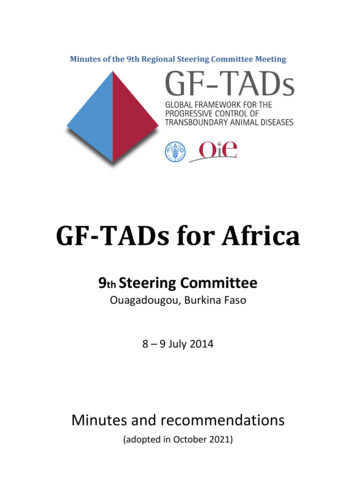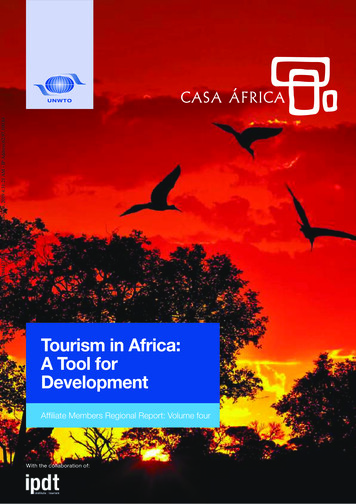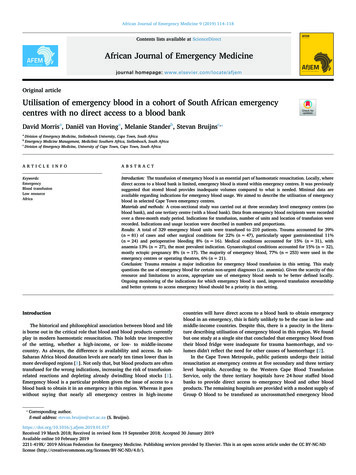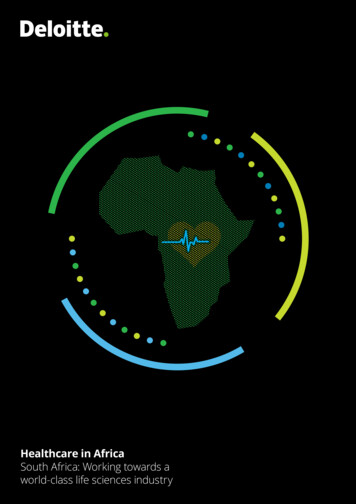
Transcription
Minutes of the 9th Regional Steering Committee MeetingGF-TADs for Africa9th Steering CommitteeOuagadougou, Burkina Faso8 – 9 July 2014Minutes and recommendations(adopted in October 2021)
Session 1:Welcome - Opening Remarks and Presentation of the AgendaThe Delegate and CVO of Burkina Faso, Dr Lassina. Ouattara, chairman of the session, welcomed the steeringcommittee and wished for good deliberations. Opening statements were received from the President of theSteering Committee (SC) and FAO Regional Animal Production and Health Officer, Dr Cheikh Ly, UEMOArepresentative Dr Soumana Diallo., Dr Baba. Soumare from AU IBAR, Dr Yacouba Samaké OIE RegionalRepresentative for Africa and Secretary of the GF-TADs for Africa. The agenda of the SC9 meeting was adoptedunanimously with minor modifications. After self-introductions of the participants (see Annex 3) the status ofimplementation of the recommendations of SC8 was presented by the Secretariat and adopted (see Annex 1).Matters arising from the discussions on the recommendations:1. Secretariat required to be provided with information regarding progress in implementation of therecommendations;2. Partners pleaded to Members Countries to improve sharing of the OIE PVS Pathway reports(evaluations and Gap Analysis) to facilitate and customise technical assistance to Members. TheMembers should use the reports when doing advocacy for development/investment; and3. Increase opportunities to exchange information between partners on opportunities for labellingactivities for GF-TADs;Session 2:Governance aspectsUpdate from the Global GF TADs, including Global Action PlanMr. Fulvio Biancifiori, Coordinator from the GF-TADs Global Secretariat presented activities at the Global andRegional levels including meetings which will be labelled under the GF TADS platform. These include the launchof global platforms for ASF and other pig diseases and their training courses to cover post mortem, samplepackaging, diagnosis etc. The west Eurasia FMD meetings by FAO/OIE intends to develop further guidance onFMD-PCP based project proposals. Each country is expected to identify and nominate focal points for the FMDPCP. Other initiatives reported were in prioritization of TADs on regional and sub-regional basis, costeffectiveness of investments in prevention of TADs. Dr Biancifiori elaborated on performance indicators thatneed to be addressed to streamline and facilitate reporting of performance. He briefed the SC9 on progressregarding the development of the GF TADs website (www.gftads.org) that will be hosted by FAO. However thesecretariat will be responsible for the costs and management. Web site Focal Points from OIE and FAO forinformation verification and accuracy have been identified. SOPs and procedures were in place. Upcomingevents were listed. (see Annex 3).Regional GF TADs for Africa 5 year Action Plan (2012-2016)Dr Y. Samaké introduced and outlined the status of implementation of the 5 year Action Plan covering diseaselist, objectives labelling process and criteria. He reiterated the need for information from members andimplementing authorities to provide the Secretariat with up to date information which is not readily available.Activities by various partner supporting the action plan were highlighted and included livestock developmentstrategy for Africa, various training courses eg FAO ASF course, diseases prevention and control strategies beingdeveloped for Africa by partners, official endorsements of national control strategies, VSPA activities on PPR,Rinderpest seqeustration activities, and reinforcement / strengthening of veterinary services in Africa. Nationaland regional Technical Cooperating Programs were also highlighted.
The partners discussed options for improving implementation of the 5 year action plan. The SC9 agreed tocollectively populate performance indicators and prioritise this work. The 5-year Action plan is to becompleted with baseline situation for the following tentative diseases: FMD, PPR, CBPP, ASF and RVF. Theupdate on diseases status will be focused on these 5 diseases reported on a template to be provided by the GFTADs Global Secretariat.The SC9 agreed to highlight and showcase Members’ benefits and success stories from undergoing an OIE PVSEvaluation and Gap Analysis so as to promote the sharing of the reports with technical and developmentpartners. Publising reports on public open access platforms (websites) such as OIE website and MemberCountries web sites such as Rwanda were given as examples that improved sharing. Partners have ben givenelectronic access to the reports by the OIE.Tsetse and Trypanosomosis complex were discussed and concluded that it was not a priority disease listedunder the GF-TADs platform.Session 3Reporting on TADs situation in AfricaUpdate on epidemiological situation in AfricaThe Epidemiological status of priority diseases in Africa in July 2013 and early Jan – Jun 2013 was presented byDr N. Mapitse from OIE. 40 of the 52 Africa Member Countries/territories reported information for 2013 andearly 2014 with the highest number reporting ASF,CBPP, FMD, HPAI, ND, PPR and Rabies.FMD continue to be the most reported TAD in Africa with 20 affected by FMD SAT1,2,3, O and A serotypes in2013 and early 2014. In 2013 Namibia, South Africa (Limpopo and Mpumalanga), Zimbabwe (Masvingo,Matabeleland North), and Tunisia. Guinea, Botswana and Zimbabwe reported reoccurrences in 2014.Notification of reoccurrence of FMD Serotype O in cattle, sheep & goats in Tunisia after an absence of 15 yearswas elaborated.List of African Member Countries (mainly in southern Africa) with official recognition of freedom from FMD(country or zone) in 2013 and 2014 with vaccination and or with zone(s) free from FMD where vaccination isnot practiced were listed. Algeria, Morocco and Tunisia are countries with official recognition of FMD controlProgram.Twenty (20) reporting African countries have been affected by PPR in 2013 and early 2014. However the diseaseis present in a number of countries in Africa and there is an increasing percentage of PPR presence globally.Angola, Algeria and Comores reported the presence of PPR in the reporting period.Mauritius and South Africa were the only Members Countries recognised as free from PPR according to theprovisions of the OIE Terrestrial Code.12 reporting countries have been affected by ASF in 2013 and early 2014 and the reoccurrence of ASF in Beninand Zambia were elaborated further.CBPP is present in Central, Eastern, Western and parts of Southern Africa, but is still absent in North Africa. 16reporting countries have been affected by CBPP in 2013 and early 2014. The SC9 discussed extensively the CBPPepidemiological situation in Guinea, Senegal and Mauritania and the neighbouring countries. Movement ofinfected animals including transhumance were highlighted as critical fators in the CBPP status. The SC9 alsodiscussed and noted the difficulties some Member Countries were facing regarding identification, traceabilityand vaccination of animals as strategies for the control CBPP.There is a global decreasing percentage of presence of HPAI. Three (3) reporting countries have been affectedby HPAI and 1 reporting country has been affected by LPAI in 2013 and early 2014 and these were Libya, Egyptand South Africa, the latter recording a new strain of H7N7 in 2013. Newcastle disease was reported by 30countries in domestic birds and 8 countries in wild birds. Other disease covered included rabies and rift valleyfever.
Commonly reported diseases in AfricaDr Hiver Boussimi from AU–IBAR presented commonly reported diseases in Africa from 2010 to 2013. A declineof Member countries reporting was from 49 to 24 (2010 to 2013) with the biggest decline observed in 2013.Disease outbreak data was presented on an annual basis, for selected diseases, data on species basis. Totallosses were quantified on total livestock units (TLU) basis and estimated on monetary value. ASF and Newcastlediseases were top diseases contributing to losses in livestock and poultry respectively. A number of challengesincluding: none reporting, under reporting and timeliness, quality of reports were highlighted. Quality alsoreferred to lack of completeness or inconsistent and technically wrong data. Poor linkage and collaborationwith other data sources and including the private sector and lack of proper validation of data contributed.Almost all major diseases are present with high prevalence rates in the continent and diseases are emergingand re-emerging in hitherto free areas. Africa suffers from incomplete animal disease information largely dueto under reporting. For improved data and information management AU IBAR proposed (i) for continuouscapacity building of MS and the RECs, (ii) comprehensive information management system in many countriesand the RECs; (iii) strengthening of collaboration and data sharing between different sectors, organizations(RECs, IBAR, OIE and FAO) and (iv) effective interoperability between existing information systems OIE/WAHIS;FAO/TAD Info, RECs IMS1 , and AU- IBAR through ARIS-2 can play a major role in data management and sharing.Update on DiseasesFoot and mouth disease Progressive Control PathwayDr Joseph Domenech on behalf of the joint FAO/OIE FMD Working Group covered the activities of the WorkingGroup, the state of play of the Global FMD Control Strategy and the related tools such as GLEWS, Network ofreference Laboratories, CMC-AH etc. The report also covered global, regional activities and work done tosupport Member Countries such as Uganda s Karamoja region, OIE FMD missions to some Asian and southernAfrican countries. The WG has prioritized resources mobilization and production of guidelines for the socioeconomic studies. He explained the linkages between OIE procedures and standards (country status/endorsement of official control programs etc.) and the PCP, the critical competences of the PVS tool and thePCP stages. A number of Northern African countries have their national control strategies endorsed by the OIE.A laboratory networking meeting for East Africa countries will be hosted by Rwanda and the key topics fordiscussion will be the identification of focal points for communication on matters of FMD PCP and possibly theestablishment of the GF-TADs Regional Advisory Group whose terms of reference are already available.Foot and Mouth DiseaseThe OIE s Scientific Commission for Animal Diseases (SCAD) s Ad hoc Group on FMD met three times in 2014and finalized the guidelines for various activities regarding FMD. Expert missions in Southern Africa were carriedout satisfactorily in Namibia, Botswana, South Africa and Swaziland. SCAD is receiving more requests onapplications for country evaluation of disease status. The SC9 noted that a number of countries were willing toput more resources on FMD control and therefore need the support of the GF-TADs partners.Peste des petit ruminants: progress on the development of a global strategyAU-IBAR presented the status of the Pan African Program for the Progressive Control of PPR. The programacknowledges and has linkages with the proposed global strategy and other sub regional strategies such as theSADC and the Horn of Africa (SHARE) program. The program which has continental, regional and national levels,has 4 phases being: 1Phase 1: Epidemiological and social-economic impact studies (Y1);Phase 2:Containment phase (Y1-4);Information management systems
Phase 3: Roll back (Y3-5) and;Phase 4: Verification and freedom (Y1)The plan forward is to continue with resources mobilisation, assist Members to develop national strategies andfoster coordination and partnerships.The development of the global strategy on PPR will continue in earnest and a meeting planned for October forAfrica will follow the FMD PCP principles and have an inter disciplinary approach. Already identified are theneeds, challenges, cost recovery issues and public private partnerships. Existing tools will be strengthenedincluding laboratories, epidemiological teams, PVM tools, vaccination tools, PVS and PPR GREN. Research andknowledge platform though is recognised as not core of the strategy will be developed. An internationalconference is planned in Abidjan in March 2015 when the PPR Global Strategy will be launched. Positiveprogress and impact of the VSPA pilot project in Ghana and Burkina Faso was noted.Dr B. Diop from the FAO emphasized that the PPR Global Strategy is being developed with a strong focus onfood security: exchanging information, protocols and methodologies to fight PPR and other small ruminantdiseases according to regional priorities. It will take into account different scenarios according to the conditionsin the field (vaccine delivery, post-vaccination monitoring tools, etc) and will be composed of regional andcountry specific strategies). The Regional TCP/SFS/3403 to build capacity building to prevent PPR introductioninto Malawi, Mozambique and Zambia will end in 2014. It includes the establishment of PPR vaccines bank.FAO/IAEA Joint Division is preparing SADC countries vet labs for PPR diagnosis through provision of PPRdiagnostic kits and conduction of PPR proficiency test in 2014/15. The Supporting Horn of Africa Resilience(SHARE) program has approved budgets for Kenya and Djibouti at 6,000,000 Euros each while for Ethiopia theapproval was pending.The e- conference - Global Research and Expertise Network (PPR-GREN) attracted 302 participants and collectedinputs from the scientific, technical and policy decision makers and interested stakeholder from 3 February to15 March 2014. It was organized by FAO and OIE with the platform hosted by FAOUEMOA reported that the region benefitted from the World Bank program to control PPR and ND and UEMOAcontributed 70% to the costs. The program is in its 3rd year.The SC9 noted the use of the acronyms for the various disease programs may create confusion for the partnersand the Member Countries and agreed to reserve certain acronyms e.g. PCP for the actual programs as agreed.African swine fever (ASF)AU IBAR presented an update on ASF Task Force jointly established by AU –IBAR, FAO and ILRI. First version ofthe ASF Control Strategy was developed with an action and components for a comprehensive strategy. Wasadopted and contributed to the regional and continental strategy. A regional TCP has been requested from FAObut still to be considered. The OIE reported on the activities of the Scientific Commission on Animal Diseases(SCAD) 2013/2014 including ASF Ad hoc Group meeting of April 2014 that updated the Code Chapter on ASFand aligned it with CSF Code Chapter. New ASF specific surveillance measures were addressed and the reportwill be discussed in September 2014 with the view for adoption May 2015. The SC9 was also updated on the“OIE - CIC Joint International Meeting on Early detection and prevention of African swine fever and other animalhealth issues at the wildlife-livestock-human interface” scheduled for Paris, 30th June – 1st July 2014.The initiative was presented in Rome in 2013 at a launch meeting in 2013 (Global platform for ASF and otherimportant swine diseases). East Africa has an ASF working Group with country focal points all coordinated byUganda. The SC (was updated on the African swine fever outbreaks in Europe reported between 2007 and June2014. Disease surveillance in wildlife (wild boar) presented a big challenge that Africa could learn from.Contagious bovine pleuropneumonia (CBPP)UEMOA presented the status of CBPP in West Africa and the Strategy and control Program for CBPP in MemberCountries. The Strategy was validated by Directors of Veterinary Services. A workshop was convened to getbaseline information on matters such as OIE PVS Evaluations, CBPP status, vaccinations, and sustainability of
networks. The recommendations of the workshop included in-service training of staff of the VS in the region,support to vaccine producers and more research.It was noted that historically there was a panel of experts on CBPP that had a positive impact on the control ofCBPP. Such expert groups facilitated the implementation of recommendations and strategies at regional and orglobal level. The SC9 recommended that such a panel be instituted. FAO updated the SC9 on the continuingwork on the Framework for Progressive CBPP Control. The outcomes of which will be driven and shown withkey performance indicators.A TCP for Gambia is near closure and the country faces challenges to undertake follow up/annual vaccinationand runs the risk of missing vaccination as scheduled. Senegal also submitted a TCP which is under review byFAO, for the provision of CBPP vaccines.Not all cattle are slaughtered at slaughterhouses which offer post mortem inspection services. The informationregarding the incidence and prevalence of CBPP is therefore under reported. There was therefore a lack ofepidemiological and social economic data to influence decision making. The control of the disease relies moreon movement restriction which was difficult to implement in extensive cattle rearing systems of Africa.Separation of the local /national cattle versus transhumance cattle is important for traceability of the diseaseand implementation of appropriate control measures. Vaccines are also not as effective. Control also requiresfinancial resources which most countries are unable to meet.The SC9 recommended that a CBPP situation for West African countries (Gambia, Senegal, Mali, Mauritania andsurrounding countries be conducted to determine the next steps which may take the form of a regionalapproach.Avian and other influenza virusesAn update of H7N9 detected in China in March 2013 was made by FAO. The infection was limited to South andEast China to 15 provinces including Hong Kong SAR and Taiwan Province. Two waves of outbreaks wereobserved from March to May 2013 and from July 2013 to now. Chicken and quail were affected. No pigs andwild birds were affected. Control measures implemented that included closure of live birds markets controlledthe outbreaks effectively showing multisectoral approach worked well.FAO developed a Regional TCP “Emergency assistance for surveillance of Influenza (A H7N9)in poultry andother animal populations in Africa” in collaboration with AU IBAR to assist countries to proactively preparethemselves in reducing the potential negative impact of H7N9 to the livelihood and human health andimproving resilience in the event of a pandemic. Target countries (11) are those that had recorded avianinfluenza in previous occasions and those that trade with China. A training workshop was conducted for thebeneficiary countries in May in Ethiopia on surveillance and epidemiology.RabiesA Stepwise Approach towards Rabies Elimination (SARE) program targeting RESOLAB region is geared towardsimproving capacity for rabies diagnosis in laboratories. The program involves training especially on ELISA andimmunoflourescent techniques, provision of laboratory supplies such as microscopes and reagents, advanceddiagnostics such as virus isolation and sequencing. The program aslo assist developing countries to set upnational control plans. The program is not prescriptive and not risk based tool and is multi sectoral. Informationsharing is by way of seminars in Africa such as the OIE regional Seminar on Rabies in Niger in 2014, internationalconferences, and the commemoration of World Rabies Day (WRD).FAO provided an update on its technical assistance to Congo Republic on the outbreak at Pointe Noire. OIEinformed the SC9 of the proficiency testing exercise on Rabies FAT with Rwanda, Cameroon, Congo Republic,DRC and Uganda conducted by the OIE reference Laboratory in South Africa. The collaboration between thelaboratory in Nantes (France) and Burkina Faso was also acknowledged by the SC9.Challenges that cover all levels were identified including biosafety/biosecurity at laboratories, multi sectoralcollaboration issues, vaccination coverage and ownership of good practices at community level. Tripartite
(FAO/OIE/WHO) involvement on the One Health approach was evidence of strong commitments from therespective organisations.Rinderpest virus SequestrationMember Countries have submitted and continue to deposit rinderpest containing material (RVCM) to AUPANVAC. However some countries are still holding on to RVCM. The joint Advisory Committee (JAC) on RVCMdid a site inspection of holding facilities in Africa and selected AU PNAVAC as a depository for the Africa region.There was only one application from Africa. The JAC has developed contingency plans in case of outbreak.Twenty two (22) countries had reported holding the RVCM to the OIE. The 2014 OIE World Assembly ofDelegates made a resolution on procedure for holding facilities and guidelines on applications. The JAC alsomade recommendations on PPR research.Rift Valley Fever (RVF)A brief on the project Vmerge including risk modelling was presented by FAO.A RVF vaccine meeting was heldin Rome in March 2014. The meeting recognised that other RVF vaccine issues were more critical than the DIVAvaccines. The RVF meeting in Dakar invited both veterinarians and Medics to discuss the disease.SF PROCNADAThe exit strategy of the program “Vaccines for the Control of Neglected Animal Diseases in Africa” (VACNADA)proposed the “African Initiative for the Progressive Control of Neglected Animal Diseases: Development of AStrategic Framework for the Progressive Control for Neglected Animal Diseases & Zoonosis in Africa” (SFPROCNADA). It is led by AU IBAR and is intended to introduce practical, proportional and sustainable measuresto control neglected animal diseases (NAD). The definition of NAD in the African context was agreed and theintervention areas such as “assessment of the socio-economic impact, coordination and partnerships” werealso determined. CBPP,TB /Brucellosis complex, ND, ASF, rabies among others were identified as NAD.The strategy is to be consolidated with inputs from Member Countries and presented to the GF TADs for AfricaSteering Committee. Resource mobilisation and operationalization of the strategy will immediately follow. TheSC9 discussed the merits and demerits of the approach to label diseases NAD and if it will attract sponsors ifelevated for resource mobilisation. The SC9 agreed that some of these diseases cannot be said to be NAD suchas CBPP and the term was received with some discomfort as these so called NAD were addressed elsewhere.Emerging DiseasesMERS CovFAO update d the SC9 on the Middle East Respiratory Syndrome (MERS-Cov) reporting that it affected mostMiddle East countries and especially Saudi Arabia, UAE, Qatar, Jordan and Yemen which reported cases. Thedisease was spread by travel. Both camels and humans tested positive and retrospective surveillance studiesshowed that the disease was present as far back as 1992. Camel rearing countries are at high alert. WHO, FAOand OIE conducted joint missions on gthe disease. The Muscat Declaration emphasised research, coordinatedsurveillance, systematic determination of source of origin and a communication strategy.Pending issues are determination of dromendary camel virues and their relationship with humans and moreresearch on the genetically diversity of the African viruses and their human infectivity.Epidemic Ebola virusOriginally found in Guinea and spread to other countries in West Africa. Fruit bats were implicated in itsepidemiology. USDA in Dakar planned a meeting between the veterinarians and medical personnel to shareknowledge and promote OH Approach on Ebol a virus disease and the terms of reference to combat theinfection re available. Bush meat management may be critical in the control of Ebola.
PEDPorcine Epidemic Diarrhoea (PED) is a recent emerging disease of swine worldwide caused by a virulent alphacoronavirus. Piglets die within 5 days and adults become sick and lose weight. Movement of swine and porkproducts will place countries at risk of PED therefore strengthening border inspection and surveillance willreduce the risk. OIE Codes on biosecurity and their related measures will help the situation. A meeting led byOIE at the request of the Members was held following the General Session in May 2014 to discuss PED. TheOIE s Regional Commission for Europe has requested to further discuss PED and Africa can benefit from therecommendations that will follow from this meeting.The SC9 reiterated the importance of multi sectoral approach (One Health) in tackling such kinds of events.Zoonotic diseases are the entry point for collaboration on OH Approach. The SC was informed that there wasa committee that was looking into naming of diseases with respect to removing any reference to regions,countries etc. which currently carries negative connotations. The committee has considered a number ofdiseases and developed guidelines on disease nomenclature for any emerging infections. The process is not yetconcluded. The possible impact of miscommunication regarding evolving situation related to emerging and reemerging diseases such as Middle East Respiratory Syndrome (MERS-CoV), Porcine Epidemic Diarrhoea (PED),and Influenza A H7N9 demands that any communication related to emerging and re-emerging diseases bebased on scientific facts and the GT TADs partners should provide the necessary guidance.Session 4Reporting on transversal topicsTrade and STDF projectsA background and mandate of the WTO STDF was made. Three grants Project Preparation Grant (PPG) arealready approved in Africa being: AU IBAR with the “Trade and Improved Livelihoods in Aquatic Production inAfrica” (TILAPIA) 50,000 USD was approved in October 2013 and will end on December, 2014. It includesparticipation of OIE, FAO (FI) and AU-NEPAD. Development of information resource on veterinary drug residuesto support trade in safe products of animal origin [CABI] was funded at a tune of 76,660 USD. The PPG wasapproved in March 2014. COMESA (Feasibility study on the concept of the COMESA Green Pass funded at90,000 USD ended on March 2014 Another PPG “Breaking barriers, facilitating trade in COMESA member states”(900,000 USD) was approved in March 2014. Ethiopia PPG “Assessment of SPS capability and building ofinstitutional capacity to enhance Sanitary applications in Ethiopia” funded at 50,000 USD was rejected in March2014. It was resubmitted in July 2014 with some amendments. The objective of Cameroon s PPG (560,000 USD)with technical support from FAO, is to enhance the control of TADs. It will end on November 2014.There were very few proposals on animal health, animal products trade, animal welfsre including bees receivedby the STDF and Member Countries were encouraged to submit PPGs.The SC9 noted with concern that the WTO seems to be pushing for its STDF’s Multi-Criteria Decision Analysis(MCDA) tool at the detriment of other technical tools such as OIE PVS (performance of veterinary services) andFAO s PCE (phytosanitary capacity evaluation) in the appraisal of project proposals and ex-post evaluations.Vet-Gov ProgrammeThe program is progressing relatively well with collaboration between OIE, FAO and AU IBAR. OIE has conducted6 legislation missions and doing a country analysis in collaboration with UEMOA. Three PVS Evaluations,9 PVSPathway follow up missions and 5 PVS Gap Analysis missions were conducted at the request of the countriesunder the VETGOV programme. The slow uptake is attributed to the fact that request are voluntary and madeby Members and not imposed on them. AU IBAR is launching and implementing policy hubs at country level.Eight (8) Pilot studies have been selected during phase 1 of the call for proposal. The second phase will fund 10pilot projects which have already undergone through the selection process. AU IBAR will continue the trainingon Veterinary Legislation in line with the RECs and will strengthen linkages with the private sector, regional
farmer organisations. Impact studies will be conducted to generate information for advocacy and lobbying forfinancial support. The legislation seminars have been agreed so for with IGAD and ECCAS FOR 2014. The FAOcomponent in support to animal health policy development and regional networks is also going well. Theprogram will undergo mid-term review in September 2014 which should showcase the tripartite collaboration.The rolling out of ARIS II is also continuing with inter sectoral collaboration between OIE and other regionalorganisations to achieve interoperability between the different reporting systems. Roadmap to ensureinteroperability was agreed between OIE and AU IBAR.An interface for the coordination of livestock policies in VETGOV between AU IBAR, FAO and OIE was seen asessential and should be started.Mobile DevicesThese are devices used in disease/event capture that can be used to speed up and improve disease reportingto the Chief Veterinary Officer (CVO) by veterinary field personnel. The tool is used extensively in Uganda andcan be customized for each country. Use of these disease reporting mobile devices started during the heightof avian influenza. The main challenge is that the database/server is not in the recipient country. However thedata is owned by the country(s) and only official animal health workers can send information to the CVO. Thereare means to verify and secure data using the mobile devices with the CVO.Session 5Reporting on GF-TADs ‘tools’ achievements in AfricaRegional Animal Health Centres (RAHCs)This topic was jointly presented briefly with updates from Mali, Tunisia, Kenya and Botswana RAHCs. The RSC9noted that the RAHCs are appropriate tool at regional level for taking in charge of control of TADs althoughthere are uncertainties regarding the funding of these RAHC. The RAHC were set up to provide technicalsupport to the RECs in the respective regions. However the linkages between the RECs and the RAHCs are weak.FAO Laboratory Mapping ToolThe
of global platforms for ASF and other pig diseases and their training courses to cover post mortem, sample packaging, diagnosis etc. The west Eurasia FMD meetings by FAO/OIE intends to develop further guidance on FMD-PCP based project proposals. Each country is expected to identify and nominate focal points for the FMD PCP.










